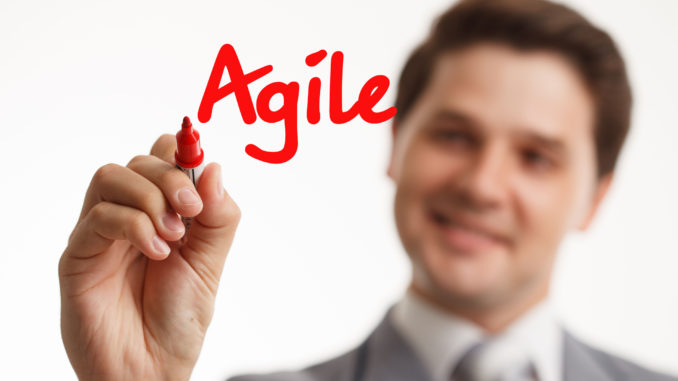
Leonard (Len) Greski is no stranger to the pages of Architecture & Governance Magazine.
From its early days, the magazine featured Greski’s thought leadership in the enterprise architecture field, with his successful stints at W.W. Grainger, Hewlett Packard, and, most recently, Travelport.
Today, Len leads the Architecture practice at LeadingAgile. He leads engagements with large clients to help them improve flow by restructuring value delivery around their business capabilities and quantifying the value of agile transformation. Len is also responsible for scaling the architecture practice so LeadingAgile can better meet the needs of its growing customer base.
What follows is a brief interview about the state of agile.
Question: What is the state of agile in terms of adoption in the technology realm? Is there more growth to be had?
Answer: Agile is all about aligning organizations’ systems and structures to their customers and markets, beyond the adoption of team-based agile practices or establishment of an agile culture. Ironically, even though agile tends to focus on adaptability, most organizations undertake agile transformation to improve predictability.
Systems-first transformation is a core belief one must adopt to improve business results with agile. Why? Systems produce the results that they’re designed to produce, and therefore, if we want to improve the results we must change the system. Practice driven approaches fail to change the systems in which agile teams work, resulting in agile teams that are constantly fighting “the system.” Culture driven practices fail because culture change is a downstream effect, not the primary cause, of systems change and practices change.
There is tremendous growth to be gained in agile transformation that produces business results. Tens of thousands of companies have invested in practices based or culture driven transformation without sustainably improving business results. Companies with ineffective product development often struggle because leaders fail to accept their responsibility for improving the system. Therefore, the greatest opportunities for agile adoption are not limited to an organization’s technology function. They require improving the organization’s entire system of delivery by restructuring its value delivery around business capabilities.
Q: Who are your typical clients and what are their typical needs?
A: Our clients are typically well-established companies in industries where there is considerable market disruption. These organizations often have invested millions of dollars in agile transformation without realizing tangible benefits. In addition to improving predictability, most clients are interested in one or more of the following goals: quality, accelerating return on investment, reducing costs, innovation, and improving product fit.
The disrupters in our clients’ industries tend to use agility as a competitive advantage, often fueled by the absence of legacy systems and structures that impede flow of value. Therefore, the well-established companies are realizing they must become more adaptable to remain competitive. However, their size complicates the change effort. In a large company one can’t change everything at once, and so we install a change system, our System of Transformation, that creates safety for leaders breaking the changes into manageable chunks.
Another distinctive of our approach is embodied in the “call our shots” principle. As we help clients establish the end state vision for their systems of delivery, we identify specific financial benefits to be achieved by improving the system and deliver them. Clients that work with us generate significant returns on their investments in agile transformation.
Q: How does a client get the most out of technology consultant?
A: To maximize value generated by an agile transformation, clients and the consulting firm need to agree on a plan that enables the client to sustain the results and continuously improve post-transformation. Our approach with clients focuses on co-creation, client leadership, and a structure to manage the organization once the consultants leave.
By co-creation, we work with our clients to tailor the structure, governance, and metrics for our System of Delivery to account for local constraints so clients can see themselves operating in the new system. We install the System of Transformation and coach a client’s executives on how to operate and measure it as vertical slices of the organization progress through their transformation journeys. Finally, as parts of the organization achieve their post-transformation state, we install the System of Continuous Improvement so the client’s executives can sustain the improvements after the consultants leave.
Q: Are you ever pulled into an area outside of technology when it comes to an agile deployment? If so, in what areas?
A: Every transformation requires changes outside the technology function to achieve sustainable business value. There are six organization-level capabilities that work against agility in an organization’s System of Delivery: Strategy Articulation, Product Management, Product Delivery, Technology & Architecture, Compliance & Controls, and Budgeting & Funding. Therefore, it is impossible to achieve business agility in a large organization without the active engagement of business functions beyond technology.
In the early stages of a transformation we manage these concerns through policy exceptions and compensating controls that improve flow. As teams become predictable we work with a client’s senior leadership to do the hard work of restructuring policies, teams, and processes that were designed to manage the lack of trustworthiness in the System of Delivery. We justify these changes based on our ability to measure improvements in predictability and quality as teams progress through their transformation journeys.
Q: What do you see as the future of agile?
A: Part of the future of agile is acceleration of the transition from agile being about team-level practices to organizations aligning their systems and structures with customers and rapidly changing markets. This type of agility is driven by business architecture, and therefore requires architects who can progress beyond traditional “architecture” responsibilities to designing organizations that can rapidly adapt by increasing the flow of value to customers. It also relies on changes to the organizational capabilities that interact with the system of delivery, and as we discussed earlier, which are difficult to change.
Another component of the future is the increased need for product-focused agility due to the pervasiveness of cyber-mechanical systems and products. When everything from your water meter to your InstantPot® is connected to the internet, the demand for new and improved software-based capabilities will expand geometrically.
